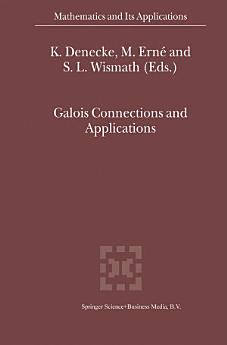Galois Connections and Applications
K. Denecke · M. Erné · S.L. Wismath
নভে ২০১৩ · Mathematics and Its Applications বই 565 · Springer Science & Business Media
ই-বুক
502
পৃষ্ঠা
reportরেটিং ও রিভিউ যাচাই করা হয়নি আরও জানুন
এই ই-বুকের বিষয়ে
Galois connections provide the order- or structure-preserving passage between two worlds of our imagination - and thus are inherent in hu man thinking wherever logical or mathematical reasoning about cer tain hierarchical structures is involved. Order-theoretically, a Galois connection is given simply by two opposite order-inverting (or order preserving) maps whose composition yields two closure operations (or one closure and one kernel operation in the order-preserving case). Thus, the "hierarchies" in the two opposite worlds are reversed or transported when passing to the other world, and going forth and back becomes a stationary process when iterated. The advantage of such an "adjoint situation" is that information about objects and relationships in one of the two worlds may be used to gain new information about the other world, and vice versa. In classical Galois theory, for instance, properties of permutation groups are used to study field extensions. Or, in algebraic geometry, a good knowledge of polynomial rings gives insight into the structure of curves, surfaces and other algebraic vari eties, and conversely. Moreover, restriction to the "Galois-closed" or "Galois-open" objects (the fixed points of the composite maps) leads to a precise "duality between two maximal subworlds".
ই-বুকে রেটিং দিন
আপনার মতামত জানান।
পঠন তথ্য
স্মার্টফোন এবং ট্যাবলেট
Android এবং iPad/iPhone এর জন্য Google Play বই অ্যাপ ইনস্টল করুন। এটি আপনার অ্যাকাউন্টের সাথে অটোমেটিক সিঙ্ক হয় ও আপনি অনলাইন বা অফলাইন যাই থাকুন না কেন আপনাকে পড়তে দেয়।
ল্যাপটপ ও কম্পিউটার
Google Play থেকে কেনা অডিওবুক আপনি কম্পিউটারের ওয়েব ব্রাউজারে শুনতে পারেন।
eReader এবং অন্যান্য ডিভাইস
Kobo eReaders-এর মতো e-ink ডিভাইসে পড়তে, আপনাকে একটি ফাইল ডাউনলোড ও আপনার ডিভাইসে ট্রান্সফার করতে হবে। ব্যবহারকারীর উদ্দেশ্যে তৈরি সহায়তা কেন্দ্রতে দেওয়া নির্দেশাবলী অনুসরণ করে যেসব eReader-এ ফাইল পড়া যাবে সেখানে ট্রান্সফার করুন।







